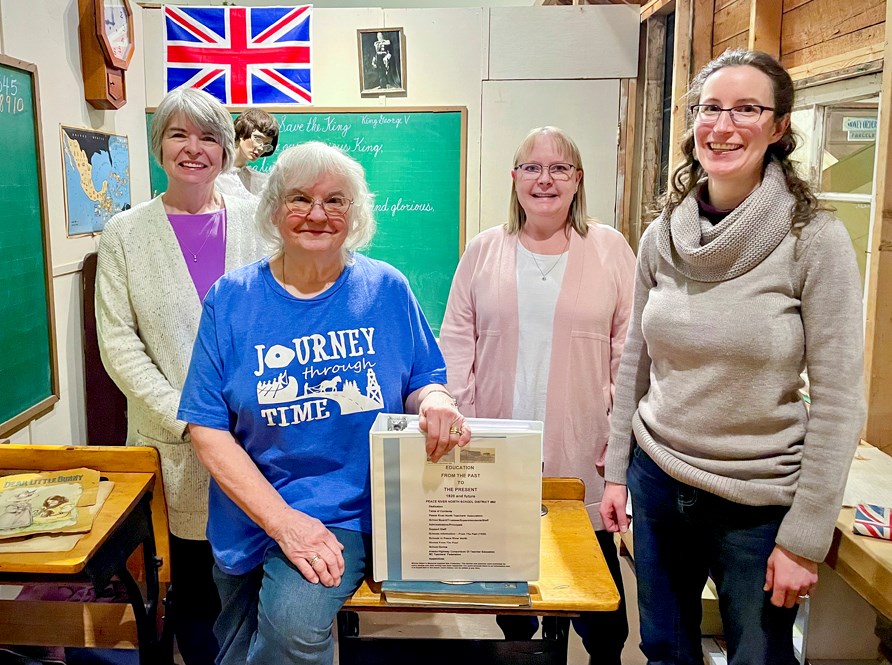The Fort St. John museum received an extraordinary gift from local teachers this week, a 500-page collection of untold stories and photographs chronicling the history of education and schools in the North Peace over the last 100 years.
The effort has been led by Margaret Little, Mary Tremain, and Michele Wiebe over the last four years, carrying on the work of Winnis Baker and her collection of personal papers, memoirs, and memorabilia previously donated to the museum.
“If it hadn’t been for her I wouldn’t have gone as far as I did,” says Little. “When I looked at her book… I realized what a treasure it was and how we needed to carry it on. We got things from lots and lots of people, stories from families that had loved ones who were teachers or went to school here."
"The stories that were given to me were incredible," she says.
The collection covers 1920 to the present, and includes a range of letters, speeches, maps, and stories from the past, from the heritage history of Pine View schools from 1931 to 1954, to memories of life in the old high school dorm in the 1950s and 60s. Cheese sandwiches anyone?
“It really builds on our collection,” says museum curator Heather Sjoblom. “A lot of what Winnis had done was the basics: how many students, who the teachers were, and so on. This is a lot more stories, and stories are what really make history come alive. It‘ll be great for exhibits and for all sorts of educational things, from social media to educational programs.”
Compiling the collection has been a cherished labour of love for Little, who began teaching at Robert Ogilvie Elementary in 1968 after growing up going to school in Pine View during the early days of the region.
“I wanted people to know education is really important and how important it was even back in the 1920s and 30s, and how the people of the communities always had a school someplace. They really valued education,” Little says.
“Some of the students walked for miles or rode horses and sleighs in the winter time. I was one of those,” she adds with a laugh. “My dad, we’d ride the horse together to school and he’d come pick me up after school.”
The project had the support of many contributors, including the Peace River North Teachers Association, Brian Low, Janice McKnight, Arlene Boon, and Dave Constable, among others. Museum researcher Tamara Secrist went “all out“ in her efforts with provincial museum and ministry archives to pull “all the names of the schools and who taught when and where," Little says.
With all the help, Little was able to find answers to some her own longstanding questions, such as where Forfar school was located: near the mouth of the Halfway River where it meets the Peace.
“It was really interesting doing Bear Flat, Attachie, Farrell Creek, and Forfar, those four schools they kept changing around,” says Little. “If there weren’t enough kids for one school they’d go to the other, it would keep moving.”
Though many schools have long since amalgamated and no longer exist, families valued education so much that they made the effort to ensure their children had the opportunity to go to school, Little said. Teachers came from across B.C. and Canada, either billeted with a family or given a little one-room teacherage to live in.
“Once a school is established that’s when a community becomes a community,” says Tremain. “Then families come. It’s not just people coming and working random jobs and leaving. They come and live.”
The current collection is a work in progress; Little says there are some gaps for additions to be made, and that she is still receiving materials and stories from former students and teachers and their families.
As for a second collection, today's students and teachers will one day become historians in their own right, gathering stories and photographs of their classroom experiences to preserve for future generations.
“History is never finished, it’s a continuation. It’s called the journey,” says Little, proudly showing off her ‘Journey Through Time’ museum t-shirt.
“I hope somebody comes along like us that values what went on in the past.”
Have an opinion or story to share? Email your letters to [email protected]



